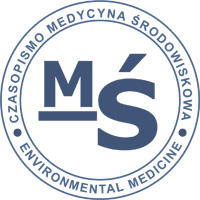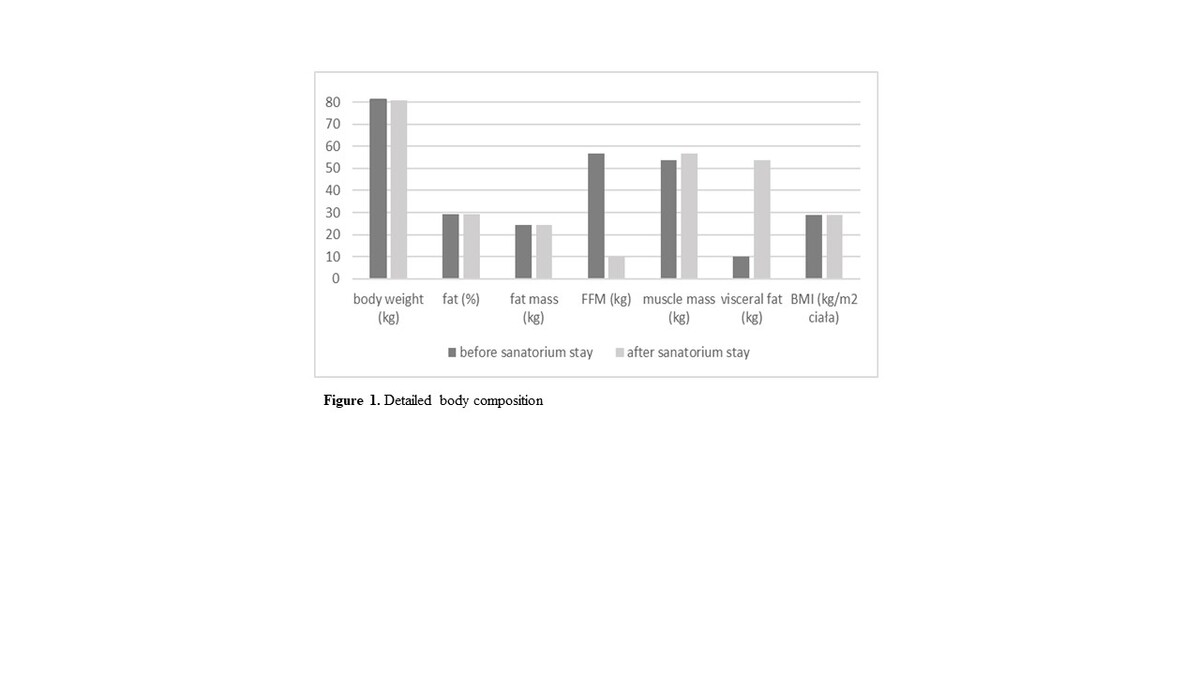Online first
Bieżący numer
O czasopiśmie
Archiwum
Polityka etyki publikacyjnej
System antyplagiatowy
Instrukcje dla Autorów
Instrukcje dla Recenzentów
Rada Redakcyjna
Bazy indeksacyjne
Komitet Redakcyjny
Recenzenci
2024
2023
2022
2021
2020
2019
2018
Kontakt
Klauzula przetwarzania danych osobowych (RODO)
PRACA ORYGINALNA
Wpływ leczenia sanatoryjnego na wzrost wartości kąta fazowego
1
Instytut Medyczny, Uczelnia Państwowa im. Jana Grodka w Sanoku, Polska
2
Katedra i Zakład Toksykologii, Analizy Toksykologicznej i Bioanalizy, Śląski Uniwersytet Medyczny
Autor do korespondencji
Med Srod. 2025;28(3):98-102
SŁOWA KLUCZOWE
DZIEDZINY
STRESZCZENIE
Wprowadzenie i cel:
Kąt fazowy jest uważany za wskaźnik integralności i funkcji błon komórkowych oraz ogólnego stanu odżywienia organizmu. Pomiar kąta fazowego może być wskaźnikiem poprawy wydolności i regeneracji u sportowców. Informuje również o nawodnieniu organizmu i występowaniu obrzęków, monitorując poziom płynów w organizmie. Celem artykułu było określenie wpływu 21-dniowego pobytu uczestników badania w sanatorium na stan ich tkanek poprzez analizę wartości kąta fazowego.
Materiał i metody:
Badaniem objęto 261 pacjentów w wieku 39–89 lat, przebywających w Sanatorium „Solinka” w Polańczyku. Pomiary kąta fazowego wykonano na początku i na końcu pobytu za pomocą wieloczęstotliwościowego analizatora impedancji bioelektrycznej Tanita MC-780 MA-N.
Wyniki:
Wyniki badania wskazują, że 21-dniowy pobyt sanatoryjny miał istotny wpływ na poprawę stanu tkanek u jego uczestników, co znalazło odzwierciedlenie w zmianach wartości kąta fazowego. Przed pobytem średni kąt fazowy wynosił 5,53°, natomiast po pobycie wzrósł do 5,69°; FK-W = 184,006. Zmiana ta jest istotna statystycznie, co sugeruje, że leczenie sanatoryjne przyniosło wymierne korzyści zdrowotne. Największy wzrost tego parametru zaobserwowano u osób korzystających z ćwiczeń w basenie i balneoterapii, co podkreśla rolę tych zabiegów w poprawie kondycji fizycznej.
Wnioski:
21-dniowy pobyt w sanatorium ma pozytywny wpływ na zdrowie komórek, co znajduje odzwierciedlenie we wzroście wartości kąta fazowego. Zabiegi fizjoterapeutyczne, takie jak ćwiczenia w basenie, balneoterapia i okłady borowinowe, są szczególnie skuteczne w poprawie kondycji tkanek.
Kąt fazowy jest uważany za wskaźnik integralności i funkcji błon komórkowych oraz ogólnego stanu odżywienia organizmu. Pomiar kąta fazowego może być wskaźnikiem poprawy wydolności i regeneracji u sportowców. Informuje również o nawodnieniu organizmu i występowaniu obrzęków, monitorując poziom płynów w organizmie. Celem artykułu było określenie wpływu 21-dniowego pobytu uczestników badania w sanatorium na stan ich tkanek poprzez analizę wartości kąta fazowego.
Materiał i metody:
Badaniem objęto 261 pacjentów w wieku 39–89 lat, przebywających w Sanatorium „Solinka” w Polańczyku. Pomiary kąta fazowego wykonano na początku i na końcu pobytu za pomocą wieloczęstotliwościowego analizatora impedancji bioelektrycznej Tanita MC-780 MA-N.
Wyniki:
Wyniki badania wskazują, że 21-dniowy pobyt sanatoryjny miał istotny wpływ na poprawę stanu tkanek u jego uczestników, co znalazło odzwierciedlenie w zmianach wartości kąta fazowego. Przed pobytem średni kąt fazowy wynosił 5,53°, natomiast po pobycie wzrósł do 5,69°; FK-W = 184,006. Zmiana ta jest istotna statystycznie, co sugeruje, że leczenie sanatoryjne przyniosło wymierne korzyści zdrowotne. Największy wzrost tego parametru zaobserwowano u osób korzystających z ćwiczeń w basenie i balneoterapii, co podkreśla rolę tych zabiegów w poprawie kondycji fizycznej.
Wnioski:
21-dniowy pobyt w sanatorium ma pozytywny wpływ na zdrowie komórek, co znajduje odzwierciedlenie we wzroście wartości kąta fazowego. Zabiegi fizjoterapeutyczne, takie jak ćwiczenia w basenie, balneoterapia i okłady borowinowe, są szczególnie skuteczne w poprawie kondycji tkanek.
Introduction and objective:
The phase angle is considered an indicator of the integrity and function of cell membranes and the overall nutritional status of the body. Phase angle measurement can be an indicator to improve performance and recovery in athletes. It also informs about hydration of the body, occurrence of swelling, and monitoring the level of fluids in the body. The aim of the article is to determine the impact of a 21-day sanatorium stay on the tissue condition of the participants by analyzing the phase angle values.
Material and methods:
The study included 261 patients aged 39–89 years undergoing a sanatorium stay at the ‘Solinka’ Sanatorium in Polańczyk in the Subcarpathian Province, south-east Poland. Phase angle measurements were taken at the beginning and end of the stay using the Tanita MC-780 MA-N multi-frequency bio-electrical impedance analyzer.
Results:
The results of the study show that the 21-day sanatorium stay had a significant impact on improving the tissue condition of the participants, as reflected in changes in phase angle values. Before the stay, the average phase angle was 5.53°, while after the stay, it increased to 5.69°, F K-W=184.006. This change is statistically significant, suggesting that the sanatorium treatment brought measurable health benefits. The greatest increase in this parameter was observed in individuals who participated in pool exercises and balneotherapy, highlighting the role of these treatments in improving physical condition.
Conclusions:
The 21-day sanatorium stay had a positive effect on cellular health, as reflected in the increase in phase angle values. Physiotherapy treatments, such as pool exercises, balneotherapy and mud wraps, are particularly effective in improving tissue condition.
The phase angle is considered an indicator of the integrity and function of cell membranes and the overall nutritional status of the body. Phase angle measurement can be an indicator to improve performance and recovery in athletes. It also informs about hydration of the body, occurrence of swelling, and monitoring the level of fluids in the body. The aim of the article is to determine the impact of a 21-day sanatorium stay on the tissue condition of the participants by analyzing the phase angle values.
Material and methods:
The study included 261 patients aged 39–89 years undergoing a sanatorium stay at the ‘Solinka’ Sanatorium in Polańczyk in the Subcarpathian Province, south-east Poland. Phase angle measurements were taken at the beginning and end of the stay using the Tanita MC-780 MA-N multi-frequency bio-electrical impedance analyzer.
Results:
The results of the study show that the 21-day sanatorium stay had a significant impact on improving the tissue condition of the participants, as reflected in changes in phase angle values. Before the stay, the average phase angle was 5.53°, while after the stay, it increased to 5.69°, F K-W=184.006. This change is statistically significant, suggesting that the sanatorium treatment brought measurable health benefits. The greatest increase in this parameter was observed in individuals who participated in pool exercises and balneotherapy, highlighting the role of these treatments in improving physical condition.
Conclusions:
The 21-day sanatorium stay had a positive effect on cellular health, as reflected in the increase in phase angle values. Physiotherapy treatments, such as pool exercises, balneotherapy and mud wraps, are particularly effective in improving tissue condition.
REFERENCJE (25)
1.
Baş D, Atahan C, Tezcanli E. An analysis of phase angle and standard phase angle cut-off values and their association with survival in head and neck cancer patients undergoing radiotherapy. Clin Nutr. 2023;42:1445–1453.
2.
Lewitt A, Mądro E, Krupienicz A. Podstawy teoretyczne i zastosowania analizy impedancji bioelektrycznej (BIA). Endokrynologia, Otyłość i Zaburzenia Przemiany Materii. 2007;2:79–84.
3.
Małecka-Massalska T, Popiołek J, Teter M, et al. Wykorzystanie kąta fazowego do oceny stanu odżywienia pacjentów z jadłowstrętem psychicznym. Psychiatr Pol. 2017;51:1121–1131.
4.
Asano Y, Nagata K, Shibuya K, et al. Association of 24-h movement behaviors with phase angle in community-dwelling older adults: a compositional data analysis. Aging Clin Exp Res. 2023;35:14691476.
5.
Martins PC, Junior CASA, Silva AM, et al. Phase angle and body composition: A scoping review. Clin Nutr ESPEN. 2023;56:237–250.
6.
Fu L, Ren Z, Liu X, et al. Reference data of phase angle using bioelectrical impedance analysis in overweight and obese Chinese. Front Endocrinol. 2022;13:924199.
7.
da Silva BR, Orsso CE, Gonzalez MC, et al. Phase angle and cellular health: inflammation and oxidative damage. Rev Endocr Metab Disord. 2023;24:543–562. doi:10.1007/s11154-022-09775-0.
8.
Kochański J. Historia polskiej balneologii w zarysie. In: Ponikowska WI, Kochański J. Wielka księga balneologii, medycyny fizykalnej i uzdrowiskowej. Konstancin-Jeziorna: ALUNA; 2017. Tom I:33–46.
9.
Antonelli M, Donelli D. Effects of balneotherapy and spa therapy on levels of cortisol as a stress biomarker: a systematic review. Int J Biometeorol. 2018;62:913–924.
10.
Helbin J, Olarzyk EK. Natural environment advantages in pharmacological treatment support. Probl Hig Epidemiol. 2005;86:22–26.
11.
Kuryliszyn-Moskal A, Hryniewicz A, Dziura J. Balneotherapy in the treatment of rheumatoid arthritis and osteoarthritis. Forum Reumatol. 2017;3:168–172.
12.
González-Muniesa P, Mártinez-González MA, Hu FB, et al. Obesity. Nat Rev Dis Prim. 2017;3:17034.
13.
Harris KK, Zopey M, Friedman TC. Metabolic effects of smoking cessation. Nat Rev Endocrinol. 2016;12:299–308.
14.
Stodolny J. Choroba przeciążeniowa kręgosłupa. Epidemia naszych czasów. Kielce: ZL Natura; 2003.
16.
Dittmar M, Reber H, Kahaly GJ. Bioimpedance phase angle indicates catabolism in Type 2 diabetes. Diabet Med. 2015;32:1177–1185.
18.
Norman K, Herpich C, Müller-Werdan U. Role of phase angle in older adults with focus on the geriatric syndromes sarcopenia and frailty. Rev Endocr Metab Dis. 2023;24:429–437.
19.
Karagülle M, Kardeş S, Dişçi R, et al. Spa therapy for elderly: a retrospective study of 239 older patients with osteoarthritis. Int J Biometeorol. 2016;60:1481–1491.
20.
Martins AD, Brito JP, Batalha N, et al. Phase angle as a key marker of muscular and bone quality in community-dwelling independent older adults: A cross-sectional exploratory pilot study. Heliyon. 2023;9:e17593.
21.
Matsumoto Y, Tada M, Yamada Y, et al. Relationship between the phase angle from bioelectrical impedance analysis and daily physical activity in patients with rheumatoid arthritis. Mod Rheumatol. 2024;34:340–345.
22.
Silva AA, de Melo GF, de Almeida Filho EJB, et al. Correlation between phase angle and muscle mass, muscle function, and health perception in community-dwelling older women. Sport Sci Health. 2023;19:713–721.
23.
Asano Y, Tsuji T, Kim M, et al. Cross-sectional and longitudinal study of the relationship between phase angle and physical function in older adults. Geriat Gerontol Int. 2023;23:141–147.
24.
Górska S, Pijanowska M. Zastosowanie borowiny w rehabilitacji i odnowie biologicznej. Gerontologia Współczesna. 2014;4:176–179.
25.
Chojnowski J. Balneoterapia i fizykoterapia w leczeniu otyłości. In: Ponikowska I. Wielka Księga Balneologii, Medycyny Fizykalnej i Uzdrowiskowej. Konstancin-Jeziorna: ALUNA; 2018. Tom II, 268–281.
Udostępnij
ARTYKUŁ POWIĄZANY
Przetwarzamy dane osobowe zbierane podczas odwiedzania serwisu. Realizacja funkcji pozyskiwania informacji o użytkownikach i ich zachowaniu odbywa się poprzez dobrowolnie wprowadzone w formularzach informacje oraz zapisywanie w urządzeniach końcowych plików cookies (tzw. ciasteczka). Dane, w tym pliki cookies, wykorzystywane są w celu realizacji usług, zapewnienia wygodnego korzystania ze strony oraz w celu monitorowania ruchu zgodnie z Polityką prywatności. Dane są także zbierane i przetwarzane przez narzędzie Google Analytics (więcej).
Możesz zmienić ustawienia cookies w swojej przeglądarce. Ograniczenie stosowania plików cookies w konfiguracji przeglądarki może wpłynąć na niektóre funkcjonalności dostępne na stronie.
Możesz zmienić ustawienia cookies w swojej przeglądarce. Ograniczenie stosowania plików cookies w konfiguracji przeglądarki może wpłynąć na niektóre funkcjonalności dostępne na stronie.



